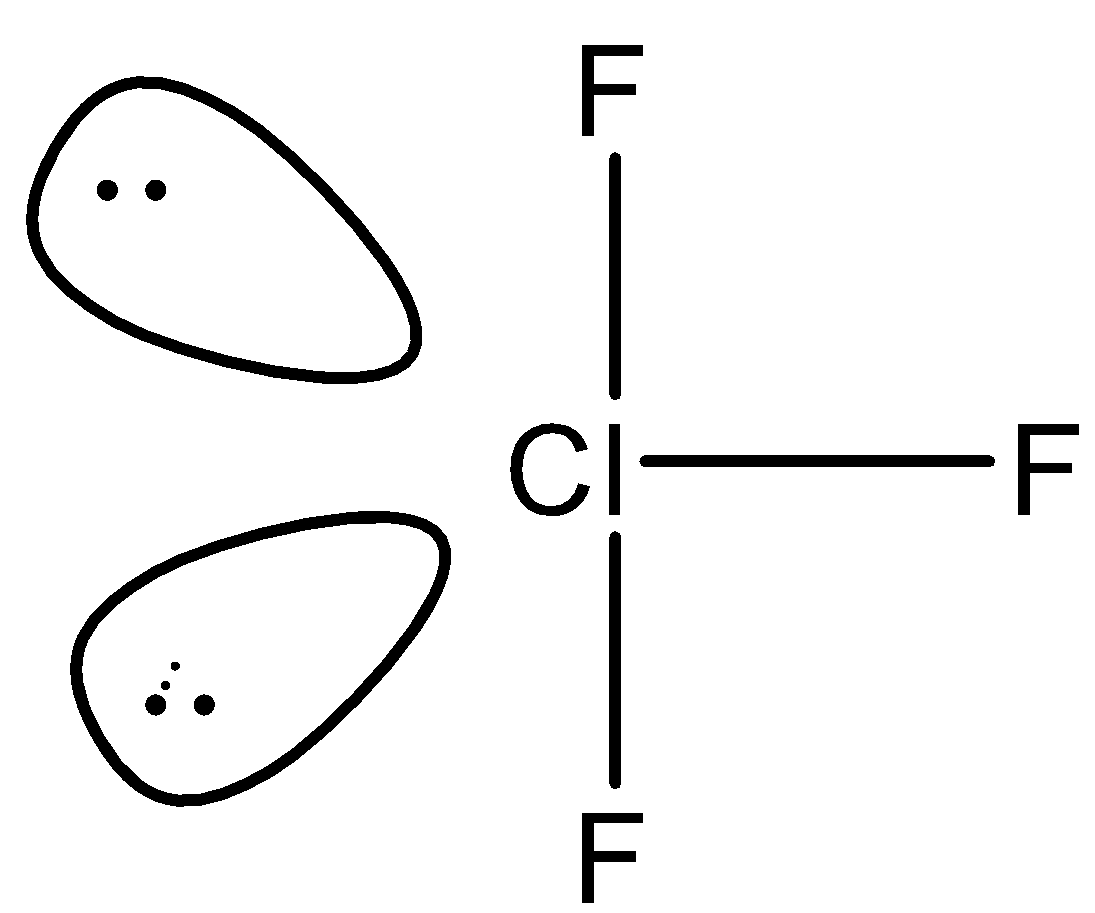
The shape of ClF$_3$ according to VSEPR model is:
a.) – Planar triangle
b.) – T-shape
c.) – Tetrahedral
d.) – Square planar
Answer
518k+ views
Hint: In this question, we have to discuss the VSEPR theory. It was based on the electron pairs, and bond pairs present around the central metal atom. On the basis of that, this theory helps to identify the shape of molecules.
Complete step by step solution: Now, first we will discuss the VSEPR theory; it stands for valence shell electron pair repulsion theory.
If we talk about the determination of shape, then it was based on the no. of lone pairs in the molecule.
So, further talking about the ClF$_3$, here it contains a total 10 electrons around the central metal atom, i.e. chlorine.
Now, if we have 10 electrons; we can say that 5 electron pairs will be there in the molecule.
We can say that chlorine is bounded to the three fluorine atoms, so there will be 3 bond pairs in the structure of the molecule.
Now, we can calculate the lone pair of the molecule, i.e.
Lone pair = electron pair – bond pair
Lone pair = 5 - 3
Lone pair = 2
Thus, we can say that there will be 2 lone pairs, 3 bond pairs in the structure of the molecule.
Now, according to the VSEPR theory; the geometry of the molecule will be trigonal bipyramidal.
So, the shape of the molecule can be represented as:

Here, we can see that this structure satisfies the all above mentioned conditions.
In the last, we can conclude that the shape of ClF$_3$ molecule according to the VSEPR theory is T-shaped.
Hence, the correct option is (B).
Note: Don’t get confused in between the theories related to the identification of the shape of the molecule. You must know that VSEPR theory is only related to the shape of the molecule on the basis of electron pairs, lone pairs, and bond pairs. There is no relation of bond angles in this theory.
Complete step by step solution: Now, first we will discuss the VSEPR theory; it stands for valence shell electron pair repulsion theory.
If we talk about the determination of shape, then it was based on the no. of lone pairs in the molecule.
So, further talking about the ClF$_3$, here it contains a total 10 electrons around the central metal atom, i.e. chlorine.
Now, if we have 10 electrons; we can say that 5 electron pairs will be there in the molecule.
We can say that chlorine is bounded to the three fluorine atoms, so there will be 3 bond pairs in the structure of the molecule.
Now, we can calculate the lone pair of the molecule, i.e.
Lone pair = electron pair – bond pair
Lone pair = 5 - 3
Lone pair = 2
Thus, we can say that there will be 2 lone pairs, 3 bond pairs in the structure of the molecule.
Now, according to the VSEPR theory; the geometry of the molecule will be trigonal bipyramidal.
So, the shape of the molecule can be represented as:

Here, we can see that this structure satisfies the all above mentioned conditions.
In the last, we can conclude that the shape of ClF$_3$ molecule according to the VSEPR theory is T-shaped.
Hence, the correct option is (B).
Note: Don’t get confused in between the theories related to the identification of the shape of the molecule. You must know that VSEPR theory is only related to the shape of the molecule on the basis of electron pairs, lone pairs, and bond pairs. There is no relation of bond angles in this theory.
Recently Updated Pages
Why are manures considered better than fertilizers class 11 biology CBSE

Find the coordinates of the midpoint of the line segment class 11 maths CBSE

Distinguish between static friction limiting friction class 11 physics CBSE

The Chairman of the constituent Assembly was A Jawaharlal class 11 social science CBSE

The first National Commission on Labour NCL submitted class 11 social science CBSE

Number of all subshell of n + l 7 is A 4 B 5 C 6 D class 11 chemistry CBSE

Trending doubts
Differentiate between an exothermic and an endothermic class 11 chemistry CBSE

10 examples of friction in our daily life

One Metric ton is equal to kg A 10000 B 1000 C 100 class 11 physics CBSE

Difference Between Prokaryotic Cells and Eukaryotic Cells

1 Quintal is equal to a 110 kg b 10 kg c 100kg d 1000 class 11 physics CBSE

State the laws of reflection of light




